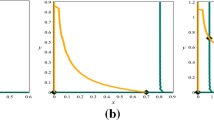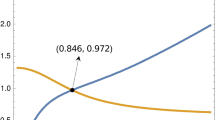Abstract
In the present paper, we propose a prey–predator model by considering some among of prey are refugees and predator interact with non refugees prey by class of functional responses. Here we also consider nonlinear harvesting for only non refugees prey. We discuss the equilibria of the model and their stability for hiding prey either in constant or proportional to the densities of prey population. Also we investigate various possibilities of bionomic equilibrium. Finally we present numerical example with graphical presentation of the various effect of the prey predator system parameter.






Similar content being viewed by others
References
Malthus TR (1798) An essay on the principle of population, and a summary view of the principle of populations. Penguin, Harmondsworth
Verhulst PF (1838) Notice sur la loi que la population suit dans son accroissement. Correspondence Mathematique et Physique 10:113–121
Lotka AJ (1925) Elements of physical biology. Williams and Wilkins, Baltimore
Volterra V (1931) Leconssen la theorie mathematique de la leitte pou lavie. Gauthier–Villars, Paris
Pei Y, Liu S, Li C (2009) Complex dynamics of an impulsive control system in which predator species share a common prey. J Nonlinear Sci 19:249–266
Santra P, Mahapatra GS, Pal D (2015) Analysis of differential-algebraic prey-predator dynamical model with super predator harvesting on economic perspective. Int J Dynam Control doi:10.1007/s40435-015-0190-1
Rebaza J (2012) Dynamics of prey threshold harvesting and refuge. J Comput Appl Math 236:1743–1752
Pal D, Mahapatra GS, Samanta GP (2014) Bifurcation analysis of predator–prey model with time delay and harvesting efforts using interval parameter. Int J Dyn Control doi:10.1007/s40435-014-0083-8
Liu M, Wang K (2013) Analysis of a stochastic autonomous mutualism model. J Math Anal Appl 402:392–403
Sharma S, Samanta GP (2015) Analysis of a two prey one predator system with disease in the first prey population. Int J Dyn Control. doi:10.1007/s40435-014-0107-4
Roy B, Roy SK (2015) Analysis of prey-predator three species models with vertebral and invertebral predators. Int J Dyn Control. doi:10.1007/s40435-015-0153-6
Holling C (1965) The functional response of predator to prey density and its role in mimicry and population regulation. Mem Entomol Soc Can 45:3–60
Chen L, Chen F, Chen L (2010) Qualitative analysis of a predator-prey model with Holling type II functional response incorporating a constant prey refuge. Nonlinear Anal Real World Appl 11:246–252
Kar TK (2005) Stability analysis of a prey-predator model incorporating a prey refuge. Commun Nonlinear Sci Numer Simul 10:681–691
Ma Z, Li W, Zhao Y, Wang W, Zhang H, Li Z (2009) Effects of prey refuges on a predator-prey model with a class of function responses: the role of refuges. Math Biosci 218:73–79
Pal D, Mahapatra GS, Samanta GP (2013) Optimal harvesting of prey-predator system with interval biological parameters: a bioeconomic model. Math Biosci 241:181–187
Pal D, Mahapatra GS, Samanta GP (2014) A bioeconomic modeling of two prey and one-predator fishery model with optimal harvesting policy through hybridization approach. Appl Math Comput 242:748–763
Pal D, Mahapatra GS, Samanta GP (2013) Quota harvesting model for a single species population under fuzziness. Int J Math Sci 12:33–46
Pal D, Mahapatra GS, Samanta GP (2015) Stability and bionomic analysis of fuzzy parameter based prey-predator harvesting model using UFM. Nonlinear Dyn 79:1939–1955
Pal D, Mahapatra GS, Samanta GP (2012) A proportional harvesting dynamical model with fuzzy intrinsic growth rate and harvesting quantity. Pacific Asian J Math 6:199–213
Devi S (2012) Nonconstant prey harvesting in ratio-dependent predator-prey system incorporating a constant prey refuge. Int J Biomath 5(2):1250021
Cai L, Li X, Song X (2008) Modeling and analysis of a harvesting fishery model in a two-patch environment. Int J Biomath 1(3):287–298
Ji L, Wu C (2010) Qualitative analysis of a predator-prey model with constant-rate prey harvesting incorporating a constant prey refuge. Nonlinear Anal Real World Appl 11:2285–2295
Chen F, Ma Z, Zhang H (2012) Global asymptotical stability of the positive equilibrium of the Lotka–Volterra prey–predator model incorporating a constant number of prey refuges. Nonlinear Anal Real World Appl 13(6):2790–2793
Ma Z, Wang S, Li W, Li Z (2013) The effect of prey refuge in a patchy predator–prey system. Math Biosci 243(1):126–130
Sarwardi S, Mandal PK, Ray S (2012) Analysis of a competitive prey–predator system with a prey refuge. Biosystems 110(3):133–148
Frisvold GB, Reeves JM (2008) The costs and benefits of refuge requirements: the case of Bt cotton. Ecol Econ 65(1):87–97
Jia Y, Xu H, Agarwal RP (2011) Existence of positive solutions for a prey–predator model with refuge and diffusion. Appl Math Comput 217(21):8264–8276
Ghosh M (2010) Modeling prey–predator type fishery with reserve area. Int J Biomath 3(3):351–365
Chakraborty K, Chakraborty M, Kar TK (2011) Regulation of a prey–predator fishery incorporating prey refuge by taxation: a dynamic reaction model. J Biol Syst 19(3):417–445
Liu X, Han M (2011) Chaos and Hopf bifurcation analysis for a two species predator–prey system with prey refuge and diffusion. Nonlinear Anal Real World Appl 12(2):1047–1061
Tao Y, Wang X, Song X (2011) Effects of prey refuge on a harvested predator–prey model with generalized functional response. Commun Nonlinear Sci Numer Simul 16:1052–1059
Ross C, Garay J (2009) A predator–prey refuge system: evolutionary stability in ecological systems. Theor Popul Biol 76(4):248–257
Li J, Huang P, Zhang R (2010) Modeling the refuge effect of submerged macrophytes in ecological dynamics of shallow lakes: a new model of fish functional response. Ecol Model 221(17):2076–2085
Mukhopadhyay B, Bhattacharyya R (2012) Effects of deterministic and random refuge in a prey–predator model with parasite infection. Math Biosci 239(1):124–130
Maynard Smith J (1974) Models in ecology. Cambridge University, Cambridge
Acknowledgments
We are grateful to the anonymous referees and the Editor-in-Chief Jian-Qiao Sun for their careful reading, valuable comments and helpful suggestions which have helped us to improve the presentation of this work significantly.
Author information
Authors and Affiliations
Corresponding author
Rights and permissions
About this article
Cite this article
Santra, P., Mahapatra, G.S. & Pal, D. Prey–predator nonlinear harvesting model with functional response incorporating prey refuge. Int. J. Dynam. Control 4, 293–302 (2016). https://doi.org/10.1007/s40435-015-0198-6
Received:
Revised:
Accepted:
Published:
Issue Date:
DOI: https://doi.org/10.1007/s40435-015-0198-6




